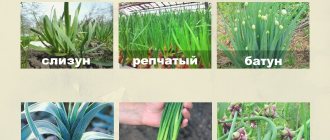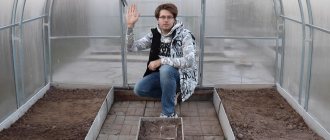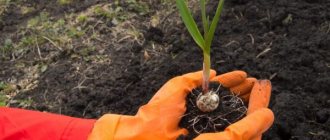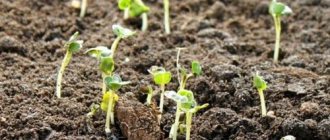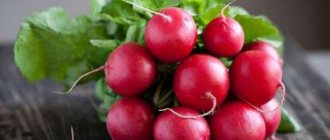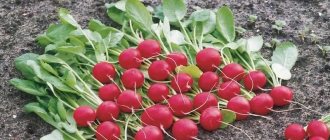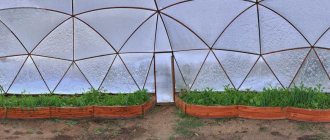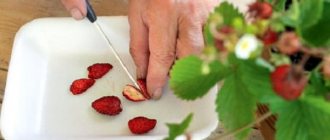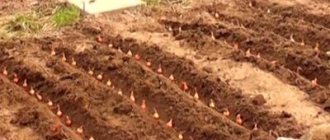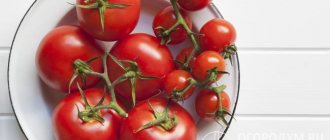Is it possible to plant onion sets before winter? Many gardeners will answer in the affirmative. Although there are those who are afraid to plant winter onions, believing that frosts can destroy them or, at best, the bulbs will go to seed in the spring. Therefore, until recently, planting winter onions was not so widespread, for the reason that many do not know how to plant onion sets correctly. Residents of cold regions are especially wary of this. I hope this article will clear your doubts.
There are several rules for how to properly plant onion sets. Let's look at them in order.
Planting dates - when to plant onion sets
Experienced gardeners recommend planting onions 1-2 weeks after planting winter garlic. Our country is large, so planting times vary in different regions. So, in central Russia it is better to sow after October 20th. The southern regions begin sowing in late November - early December. In more northern regions, sowing dates will be slightly earlier than in central Russia.
Sometimes it is advised to plant seedlings on frozen ground. This is not entirely true. Before frost, the bulbs must take root, but do not have time to shoot, otherwise they will freeze. Therefore, the optimal period is 3 weeks before permanent frost. To avoid mistakes, you will have to listen to weather forecasts.
Danilovsky
Refers to mid-season varieties. It has good yield and good keeping quality. The color of the bulbs is red-violet, the shape is flat-round. They grow up to 150 g. The taste is semi-sharp, with sweet undertones. The variety is relatively resistant to mildew.
| Use | Taste | Growing method | Bulb weight | Keeping quality |
| spicy | 50-100 | good |
Preparing onions for planting
To protect yourself and prevent onions from bolting in the spring, although the likelihood of this is low, the bulbs are warmed up before planting. Before planting, they must be immersed in warm (60º) water for 2-3 minutes. This is a proven method, safe, and guaranteed not to give arrows to the bow.
Immediately before planting, it is recommended to soak the bulbs in a weak solution of potassium permanganate, saline solution, phytosporin, etc. If you decide to soak in phytosporin, do not mix it with other solutions, since it is a biological product. Of course, disinfection won’t hurt, but many people plant dry planting material. On the one hand, soaked onions will sprout roots and take root faster, but on the other hand, autumn is unpredictable, frosts can come unexpectedly. But dry sevka will do nothing.
Where to plant onions before winter
Choosing a place for winter planting of onion sets is not important - this crop will take root well and grow on classic ridges, on high ones, and in greenhouses. However, if you plant onions in a greenhouse before winter, they will turn green much earlier than their outdoor counterparts. If you don’t have a greenhouse, but want to add onions to your salad in April, just cover the garden bed with spunbond or film as soon as the snow melts.
Since onions can easily tolerate light frosts, there is no point in planting them in a warm bed; leave it for more delicate crops. In addition, if your region has a mild and prolonged autumn, with such heating the onions will have time not only to take root, but also to begin to grow, and then inevitably freeze, which will have a bad effect on next year’s yield.
Selecting a location and preparing the bed
Onions love good, fertile, loose soil with neutral acidity. He does not like clayey, acidic soil. Therefore, choose a sunny, ventilated place, where the snow melts faster in spring. It is important that water does not stagnate in this place; excess moisture has a detrimental effect on the bulbs.
If the soil is sandy, then sand is not added, but if the soil is dense, sand must be added. The sand will serve as drainage and increase the air permeability of the soil. It’s good to add compost, it adds looseness to the soil and provides good nutrition. Be sure to add wood ash. Ash nourishes, disinfects, loosens and deoxidizes the soil.
Although onion sets are an unpretentious crop, they are not friendly with some neighbors. The best neighbors for winter onions are carrots, parsley, strawberries, and cucumbers. Good predecessors for it are potatoes, tomatoes, cucumbers, carrots, zucchini, eggplant, parsley, celery. You should not plant next to garlic and sow it in the bed where it used to grow.
Site selection, predecessors
Onions love sunny, dry areas. Beds where water stagnates are completely unacceptable. If the entire dacha plot is located in a low place, you need to form high beds by adding additional soil.
It is better to place the garden bed on the southern slope of the site. This way the plants will be protected from the piercing wind. Drained humus-loamy soils are optimal for onion plantings.
To obtain a good harvest, it is important to observe crop rotation.
Table. Predecessors for the bow
| Good | Bad |
|
|
Important! Onions can be returned to their original place no earlier than after 4 years.
At what distance to plant onion sets?
In the prepared bed, grooves are cut at a distance of 20-25 cm and a depth of 5-7 cm. This is done not only in a bed special for onions. For example, onion sets are planted between green manure.
The soil in the grooves is sprinkled with sand or drainage is applied. Without sparing, they pour ash on top. Everything is mixed with the earth. Then the bulbs are planted, without pressing into the soil, bottom down, at a distance of 7-10 cm from each other. If space allows, then plant onions on turnips and greens nearby. Then the distance between the bulbs is halved - 4-5 cm and they are alternated: for turnips - for greens, etc. This is convenient, since in the spring until half of the summer the green feather is pulled out earlier, and the turnip will continue to grow.
When sowing on greens, the bulbs are planted very tightly, literally bulb to bulb (1-1.5 cm). By planting in this way, it is possible for 1 sq. m plant up to 1 kg of onions, the result is a lot of feathers.
Landing technology
If the soil and planting bulbs are prepared, you can proceed directly to the planting procedure. It is performed according to the following algorithm:
- planting grooves are made in the garden bed;
- the distance between rows is taken to be about 20 cm;
- for small onions, the depth of the furrows is 5 cm, for large-sized fractions - 8 cm;
- place the bulbs in the grooves so that the planting step is 7 cm;
- pour a seven-centimeter layer of prepared soil mixture on top of the bulbs;
- The bed is leveled and compacted a little.
Important! The larger the planted bulbs, the greater the spacing in the row between them and the planting depth.
At what depth to plant onion sets?
After the bulbs have been laid out, the furrows are covered on top with fertile soil or compost to the level of the edge of the furrows; there should be 3-4 cm of soil above the bulbs. Planting too shallow leads to the bulb freezing in winter; planting too deep may prevent the delicate feather from breaking through the thickness of the earth. The bulb may dry out or become wet in the spring.
It is not advisable to mulch the bed right away; this is done after persistent cold weather. Mown grass, fallen leaves, dry sawdust, carrot tops, and marigold stems are used as mulch. Marigolds, among other things, repel many pests. In the spring, be sure to remove the mulch from the garden bed so that the earth warms up faster.
It is not advisable to mulch the beds with peat, especially in a thick layer. Peat is moisture-absorbing, and in the spring it lies frozen for a long time. But a delicate onion feather cannot penetrate the thickness of the ice. Finally, peat greatly acidifies the soil, and onions react very strongly to this.
A good option is to sow winter seed and carrots in the same bed. In the fall, onions are sown first, leaving one furrow for carrots, which are sown later on the frozen ground. The advantage is that they will protect each other from pests. The sets are planted together not only with carrots, but also in a bed with strawberries to save space. At the same time, it will protect strawberries from fungal diseases and pests.
Care after landing
There is just over a month left from the moment of planting to the cold weather, so caring for onions is as follows:
- If the weather is dry and warm after planting, you can do 1-2 waterings before the cold weather.
- A couple of weeks before frost, the beds are mulched with straw, dry leaves or peat. In the south, where winters are mild and not accompanied by severe frosts, it is not necessary to mulch onion beds.
Beginning gardeners in the fall often think about whether it is necessary to additionally cover the beds for the winter from freezing of the bulbs. There really is a need for this in areas where there are frosty, snowless winters. Usually the beds are covered with tops of vegetable plants.
At the beginning of winter, while there is little snow, it is recommended to collect it and throw it on the garden bed with a shovel. Snow is an excellent insulator for the soil; it will protect against any frost.
If you choose the right time for winter planting and do everything in accordance with the recommendations outlined in this article, the onion plantings will overwinter well and produce a good harvest.
Advantages of winter planting onion sets
- Sevok planted in the fall is stronger and resistant to diseases and pests;
- Less damaged by pests, such as onion flies. At the time of summer, the onion fly is near the bulb. As a rule, a strong root system is formed and the pest cannot lay larvae in the bottom;
- Crops do not require watering for a long time - almost until half of May;
- It ripens 1-2 months earlier than those planted in spring. Greens or early ripening vegetables are then planted in the vacated beds;
- Early harvesting allows the turnips to dry well in the sun and then under a canopy. Well dried, it will be better stored until spring;
- Winter onions are stronger, healthier, and therefore will be stored better.
- Onions planted in the fall are sweeter.
There is also a drop of ointment in the ointment. Turnips grown from sets do not tolerate long-term storage; their yield is somewhat lower than that of spring ones. Of course, our breeding scientists are trying to take this factor into account and are working on developing productive and cold-resistant varieties.
I wish you good harvests!
Winter onion varieties
We offer you an introduction to some varieties of winter onions, from which you can choose those that are suitable for growing in your area.
- Rubin is a variety of Donetsk selection. Early ripening onions with a growing season of 72-85 days with good keeping quality and a yield of 3 kg/m². A round bulb weighing 50-80 g, light purple in color with a silvery tint.
- Siberian annual is an early ripening variety with a growing season of 60-70 days, strong foliage, semi-sharp taste, round-flat yellow bulb. A variety with good keeping quality and resistant to bolting. Productivity 4 kg/m².
- Robin - has the richest red color of all red onions. This hybrid has a powerful root system, tolerates drought well, and is productive. Its bulb is in the shape of an amphora. The variety was developed for cultivation in the southern regions.
- Muzona is a mid-early variety that ripens from sets in 90-110 days. The bulbs are dense, round, white, weighing 100-120 g. This variety of onions can be stored for two months. Cold-resistant.
- Lugansky is a late-ripening variety with a sharp taste and good keeping quality. The bulb is round - flat or oval, the integumentary scales are yellow or yellow-brown, the weight of the bulb is 70-145 g.
- Buran is a variety of Ukrainian selection for universal use with a round dense bulb of intense yellow color weighing up to 100 g. Keeping quality is good, the yield is stable, but is affected by downy mildew.
- Tamara F1 is a mid-early hybrid with dense bulbs with yellow-brown scales and a semi-sharp taste. It can be stored for a long time, is resistant to fusarium and pink rot, and is highly productive.
- Black Prince is a mid-season variety of Russian selection of high keeping quality with a semi-sharp taste and dense round bulbs of a dark purple color.
- Stuttgarten Riesen is a German variety with flat and flat-round bulbs of golden brown color and a pungent taste. Keeping quality is good, but is affected by neck rot and powdery mildew.
- Panther F1 is a variety of Japanese selection with a bronze-brown round bulb and a thin neck. The variety is resistant to bolting and cold-resistant - can withstand -28 ºC.
Features of planting and growing
The main requirements in choosing planting material are the size of the bulb and its condition . It is easier for a small onion to survive the winter in the ground. For planting, use first-grade onions or wild oats (onion sets).
Is it possible to plant before winter and how?
To obtain a rich harvest, preliminary work is carried out to prepare the planting site, soil, and seed material. For pre-winter sowing, choose hybrids and varieties designed for average, short daylight hours.
In places with difficult weather conditions, the issue of covering beds is taken seriously. This is the only way to avoid freezing of plants.
Preparing for landing
Onions are prepared 2 weeks before planting. Choose healthy ones, without signs of damage, with a diameter of no more than 1 cm to obtain only the head, and with a diameter of 1-2 cm if you plan to also obtain greens. The bulbs are not soaked and the neck is not cut off.
Important! 7 days before planting, the bulbs are dipped for 10 minutes in a solution of potassium permanganate or copper sulfate, then thoroughly dried for 12-24 hours.
Soil requirements
Choose a well-lit place on a hill where moisture does not stagnate and snow melts quickly. A bed with loose soil and a neutral pH is suitable. They follow the rules of crop rotation: beets, tomatoes, rapeseed, cabbage, mustard, and grains are considered the best predecessors.
While digging the beds, fertilizers are applied in the form of humus at the rate of 1 bucket per square meter. Add a composition of 2 tablespoons of superphosphate, the same amount of wood ash, 1 tablespoon of urea. Acidic soil is neutralized by adding lime, chalk, superphosphates, and stove ash.
Dates, scheme and rules of planting
Be sure to adhere to planting deadlines . By planting too early, you run the risk of early shoots and crop destruction from the cold. By being late, they miss the moment when the onion forms the root system - without developed roots, the plants will not survive the winter. The best time for sowing is November in the southern regions, September in the northern regions.
A more precise period depends on the climatic characteristics of a particular region . Usually they take into account the air temperature and the forecast of weather forecasters: if frosts are promised in 14-16 days, the air temperature does not rise above 5°C, it’s time to start planting.
The sets are planted in rows at a distance of 40-45 cm , maintaining 5-6 cm between bulbs to a depth of 3-8 cm, depending on the size of the bulb. When finished, the beds are covered with straw or grass.
Note! In regions with snowy winters, the beds do not need to be covered.
Features of cultivation
After planting, the beds are mulched before frost sets in, this way moisture is retained . With the arrival of spring, the shelter is removed so that the earth warms up better. It has been noticed that onions planted before winter require weeding much later and are less susceptible to diseases and pests than their spring counterparts.
Senshu Yellow
The above-ground green part of the plant grows 50 cm high, the leaves-feathers are wide, rich green, juicy. The turnip is round, somewhat flattened, and under favorable conditions reaches 250 g.
It has good resistance to typical onion diseases, especially powdery mildew. Doesn't shoot.
| Use | Taste | Growing method | Bulb weight | Keeping quality |
| spicy | 160-180 | good |
Preparation of planting material
Before you start planting onions, you need to calibrate the heads for wild oatmeal, sets of categories 1 and 2, and sampling. It is necessary to select healthy, ungerminated, undamaged specimens.
To get a good crop harvest, some gardeners recommend soaking the seeds for the following reasons:
- for quick rooting;
- in dry soil;
- for the purpose of disinfecting bulbs from diseases.
Important! You should not trim the tops of the heads, as this will stimulate leaf growth.
Advice from experienced gardeners
A few recommendations from experienced farmers:
- Onions planted close to each other are broken through in the spring, leaving only strong, high-quality specimens with a distance of 8-10 cm.
- Several varieties are planted at once. Thus, after harvesting, the most productive crops are selected for further cultivation.
- It is better not to use film as a cover.
- Fresh manure is not suitable for fertilizing onions.
- To prevent the bulb from becoming green, the bed is watered with boiling water before planting, and the material is dipped in a solution of potassium permanganate for 10-15 minutes.
Snow globe (Snowball)
The variety is early ripening, cold-resistant, exceptionally productive. The bulbs are pure white, round, well-aligned in shape. The taste is semi-sharp. High resistance to diseases. Does not apply to keeping varieties.
| Use | Taste | Growing method | Bulb weight | Keeping quality |
| semi-sharp | 70-100 | average |
Harvesting and storage
The harvest of winter onions begins in early summer, when the onion feathers dry out and fall to the ground. By this time, all the nutrients from the feather and roots are transferred to the head. The growth of the bulb stops, the cover leaves dry out and acquire the color characteristic of the variety.
Onion harvesting is carried out in dry, warm weather. To do this, carefully dig up the bulbs with a small spatula and pull them out of the ground by the feather. After this, the vegetables are laid out in a ventilated place to dry.
Well-dried onions are trimmed before storing. Using scissors, remove long roots and dried feathers, leaving a neck 4-6 cm long. The cut onions are dried for another two weeks, after which they are removed to the main storage location.
Before storing, vegetables are carefully sorted, removing damaged and rotten specimens. Healthy bulbs with dry necks are left for storage.
At home, onions are stored in vegetable baskets, wooden boxes, fabric bags, nylon stockings or nets. All containers must have holes for ventilation. For better preservation of vegetables, they are scattered into boxes or bags in a layer of up to 30 cm.
Store onions in the basement on racks or in trays at temperatures from zero to minus 3 degrees with a humidity of 75-90%. During home storage, the optimal temperature is plus 18-22 degrees with a humidity of 50-70%.
On a note!
When storing onions in plastic bags, the vegetables quickly become damp and rot.
During storage, the onions are sorted every month, removing rotten vegetables. If the onion is damp, carefully sort it, dry it and put it in a dry container.
comparison table
| Variety | Maturing period (days) | Weight (g) | Yield (kg/m²) |
| Radar | 85-95 | 100-150 | 8 |
| Shakespeare | 75-80 | 90-100 | 3,5 |
| Red Baron | 95-100 | 130-150 | 3 |
| Arzamas local | 50-80 | 85-100 | 1,5-3 |
| Hercules F1 | 70-85 | 160-180 | 4-6 |
| Stuttgarten Riesen | 75-85 | 60-140 | 6-8 |
| Centurion F1 | 90-100 | 90-130 | 4-6 |
| Senshui yellow globe | 75-85 | 160-180 | 4 |
| Troy | 75 | 80-90 | 5 |
| Sturon | 100-110 | 150-180 | 7 |
| Viking F1 | 105-110 | 140-160 | 5,5 |
| Ellan | 75-80 | 120-140 | 3 |
| Keep Well | 90 | 100-150 | 4-6 |
| Winter | 75-85 | 90-120 | 3-4 |
| Wolf F1 | 65-80 | 140-150 | 4 |
Right time, right place
It is impossible to name the exact date for the start of planting onions before winter. Each region has its own deadlines. For the middle zone climate, it is optimal to start work in early to mid-October, but in each case you need to focus only on local conditions. It is clear that there is no point in planting in frozen ground, but planting too early can also bring problems - the set may “wake up” ahead of time if the weather is too warm. If this happens, the greens will freeze and the entire future harvest will die.
Planting too late will not give the bulbs the opportunity to take root; they will simply be stored in the ground until spring. As a result, you can forget about the early harvest, all the benefits of winter planting disappear. It is recommended to base your choice of time on soil temperature. When the soil maintains a stable temperature of about + 5°C, it’s time to plant winter onions.
Timely planting of onions will give a rich harvest
Checking the soil temperature is quite simple. Make a small hole (5-10 cm) and lower an ordinary external thermometer (not a medical thermometer!) into it. Repeat measurements several times throughout the day. The average measurement will be the stable soil temperature.
You should not plant a garden bed in the same place for more than two years in a row. Only in four years will it be possible to return to the previous site. Alternate crops to increase productivity. Onions take root well after grain crops, beets, tomatoes, cucumbers, and cabbage. But potatoes, parsley, and celery can “inherit” their diseases through the soil. It is convenient to plant winter onions as a “second wave” after the early varieties of radishes, carrots and beets.
Onion beds are located in an open, sunny, but protected from the wind place. Humus-sandy soil or loam is suitable. The selected area must be well drained; stagnation of moisture can lead to rotting. A weak root system will not be able to find nutrients in poor soil, so the bud must be fertile. Before work, you need to loosen the soil well and add humus (5-6 kg per square meter) and mineral fertilizers (10-15 g of potassium salt and 20-25 g of superphosphate per square meter). Just before you start planting, scatter the ash (about 10 g per square meter).
Varieties and hybrids
Among the winter varieties of onions, the following are popular :
- Shakespeare;
- Senshui;
- Centurion F1;
- Struton;
- Strigunovsky;
- Red Baron;
- Snowball;
- Buran;
- Robin.
Planting varieties not intended for winter cultivation will lead to abundant bolting of bulbs in the spring and loss of yield.
